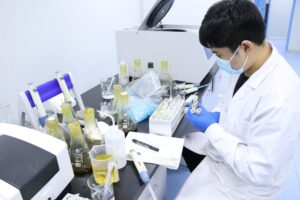Amino acids are the building blocks of protein and essential for growth, maintenance and reproduction in poultry. Lysine is the first limiting amino acid in poultry, meaning it must be present in proper amounts for birds to utilize all other amino acids in feed for muscle development and productivity. With today’s fast-growing and high-yielding birds, lysine requirements are critical to support performance and health.

Lysine impacts several biological processes in poultry:
•It is involved in the absorption and retention of other amino acids for protein synthesis. Without adequate lysine, supplementary amino acids are wasted.
•It is vital for the structure and function of muscles, connective tissues, organs, feathers, eggshells and immunity components like antibodies.
•It promotes growth regulation through its role in producing muscle-building hormones like insulin-like growth factor 1.
•It supports bone health and leg strength as a precursor to carnitine, which transports lipids for energy use. Weak legs reduce mobility, feeding and performance.
•It improves feed conversion by reducing excess fat deposition. Lysine drives muscle growth over fat storage.
•It enhances egg production and hatchability. Lysine is a major component of egg proteins and embryos.
Meeting lysine requirements brings significant benefits to poultry operations:
•Maximized growth rates, meat yields and breast muscle from efficient protein utilization.
• Optimized egg numbers, size, shell quality and hatchability.
•Better flock uniformity through balanced nutrition at each life stage.
• Improved leg health, mobility and welfare.
•Lower feed costs by avoiding excess supplements to compensate for limiting amino acids.
•Increased profits from high-quality products and productivity.
•Stronger brand integrity from a reputation for science-based management and quality.

To leverage the power of lysine in your poultry feed, follow these best practices:
1. Have a nutritionist determine the ideal lysine level for each life stage based on factors like breed, gender, diet type and whether for meat or egg production.
2.Source high-lysine ingredients like soybean meal or use supplemental lysine in diets where ingredients fall below requirements. Compare costs to determine best value.
3. start chicks with the recommended lysine level for maximum early muscle and bone development. Adjust based on results over time.
4.Monitor body weight, feed efficiency, egg production, and flock mobility issues to determine if lysine levels require fine-tuning. Make changes between flocks based on performance.
5.Keep accurate records of feed lysine levels and resulting metrics like final weight, yield data, egg numbers and any health challenges. Review periodically to make ongoing improvements.
6.Stay current with the latest research on maximizing high-tech genetics through nutrition. What satisfies needs today may require re-evaluation tomorrow based on ongoing scientific discoveries.
Amino acids are only as valuable as the most limiting one. By knowing and meeting lysine requirements, supporting protein synthesis and optimizing its biological roles, poultry producers gain a proven, sustainable foundation for performance and profitability. Provide lysine, build on success.

